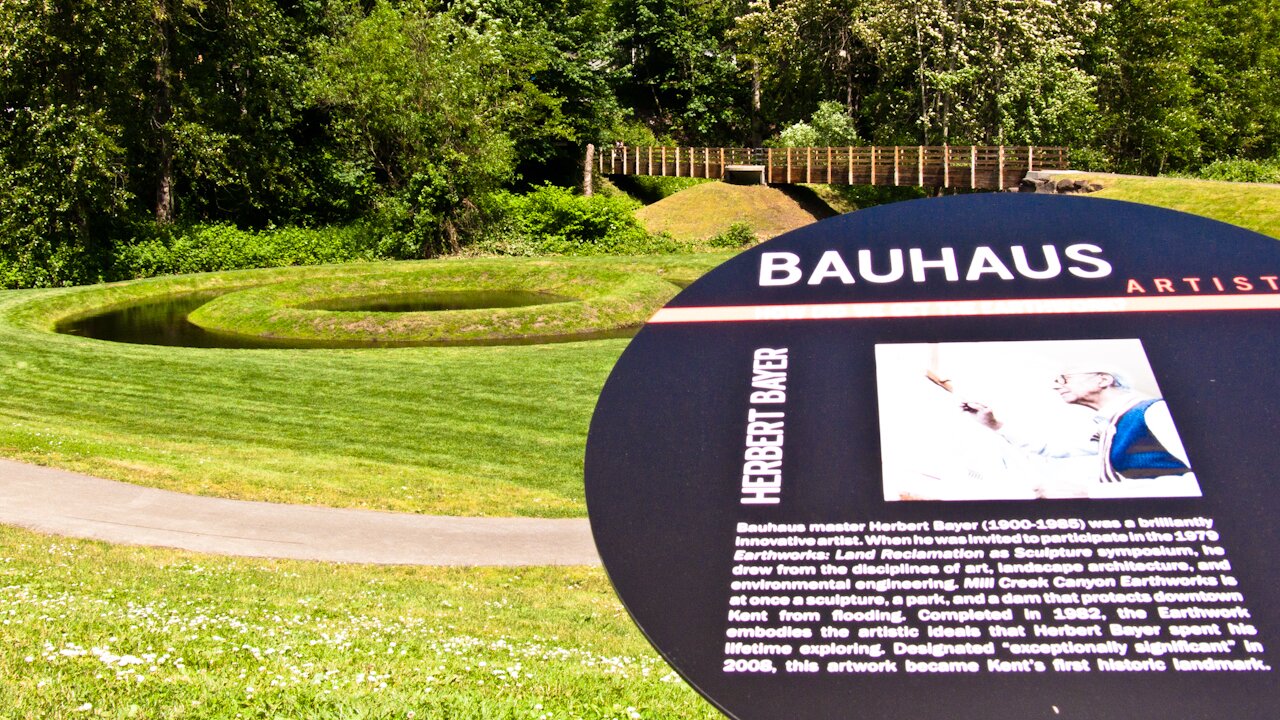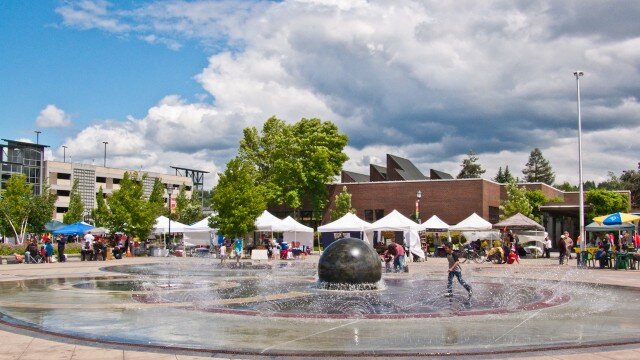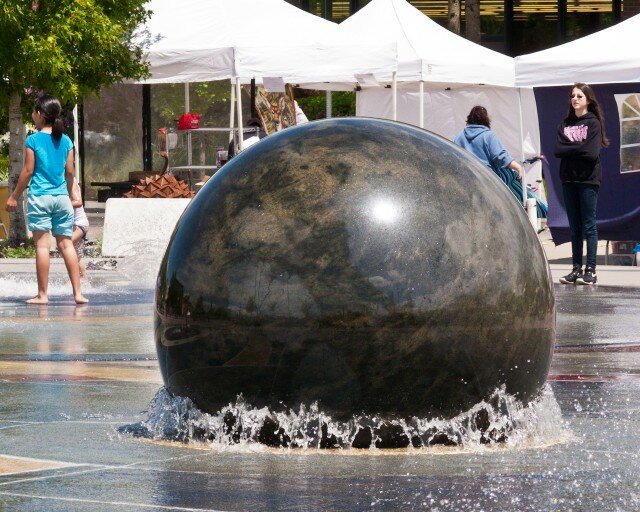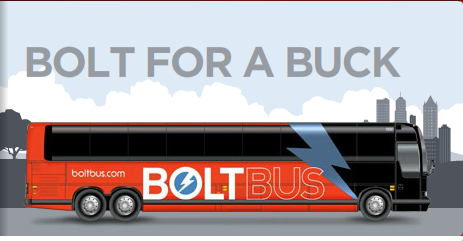We’re traveling a bit west for Glimpses’ return from a short hiatus – all the way to the coast, to be exact. “Beach ride” by zenobia_joy finds us over in Long Beach, WA contemplating the salty air and the wind rushing through the dunes…
Tag Archives: bike
Touring Kent’s World-Renowned Earthworks by Bike
Sharp-eyed readers will note that for our purposes, largely due to the Seattle-centric focus of The SunBreak, the hamlet of Kent (né Titusville) does not exist. This isn’t an affectation. Until this weekend, I’d never been closer to Kent than SR 167. So when Seattle Bike Blog announced a new Earthworks public art tour in Kent this past weekend, SunBreak Biking Correspondent Jonathan Dean and I had to consult several maps to locate where, precisely, Kent was, and how best to get there.
We’re pleased to confirm that there is “fun in Kent,” especially on weekends, thanks to the Kent Farmers Market. Hungry cyclists will be pleased by the availability of cookies and cupcakes.
The other good news is that the Green River Earthworks aren’t going anywhere, and so you can visit them by bike any time you feel like–even, or especially, in inclement weather. (Here is the link to a PDF guide that I can’t get to open.) From Seattle, it’s easy enough. You can either pick up the Green River Bike Trail by West Seattle and bike to where it meets the Interurban Trail, or take Central Link light rail to the Tukwila station, and bike down Southcenter Boulevard to where it meets the Interurban Trail, just before crossing the Green River.
The past weekend, Kent was celebrating the restoration of Herbert Bayer’s Mill Creek Canyon Earthworks, which “combines Bauhaus aesthetics with a functioning water detention dam,” and that served as the basis for a 23-mile bike ride that also included the Robert Morris Earthwork, the Green River Natural Resources Area, and Lorna Jordan’s Waterworks Garden.
You didn’t know that Kent boasted an earthwork by a major Bauhaus artist, did you? (Graphic designers will know Bayer as the creator of the Universal typeface.) Here is a short film about Bayer’s earthwork. The restoration effort meant improving “drainage in the bowls, repav[ing] the pathways and reshap[ing] the double-ring pond,” along with “re-sodding the double-ring pond, and restoring the view corridor along the stream.” And it was thanks in part to online voting, since $70,000 came from that American Express and the National Trust for Historic Preservation’s “Partners in Preservation” competition, where people voted for their favorite cause.
The Robert Morris Earthwork, from the same time period, is a conversion of an old sand and gravel pit that went defunct in the ’40s. It’s almost four acres up a steep hillside, terraced, and planted with rye grass that bends cinematically in the wind. As you venture down the circular paths deeper into the bowl, urban sounds drop away, and you get nothing but the breeze and birdsong. Defeated by the hillclimb, even in my lowest gear, I had to walk the last half, though Dean somehow powered up it.
The Green River Natural Resources Area looks, riverside, like much of rest of Green River you see from the bike trail. The difference is in the absence of encroachment by homes, industrial warehouses, and golf courses. I’m told there are observation towers, but we pressed on in our attempt to get to the Waterworks Garden before being cocooned by the blasts of pollen being emitted.
The entrance to the Waterworks Garden isn’t necessarily obvious, by bike from the Interurban. For such a major work, it’s short on signage announcing its presence. (This was true of all of the works actually, despite the 65 orange poles I’m told map the route–I counted about twelve. Some have QR codes so you can smarten up via smartphone, which is nice. But I would have preferred to see the more conventional brown arrows that point you toward cultural sites.) Once you find the garden, though, all is forgiven. Endless forms, meet function. Stormwater is filtered through a series of pools, surrounded by an abundance of native foliage.
At this point, you’re in Renton, and you have to make the decision of how to return to Seattle. You can take the flatter Green River Bike Trail back, and perhaps catch the King County Water Taxi to downtown, or resign yourself to the long upward slope of Southcenter Boulevard, back to the Tukwila light rail station. Light rail is probably the faster way, unless you happen to expire during the climb.
Glimpses: “ready to ride”
In honor of Bike to Work Day, we showcase two alternative modes of commute seen around the Seattle area. Thanks to ChrisBlakeley for dropping this shot into our Flickr pool.
Yes, New Seattle-to-Portland BoltBus Service Will Take Bikes
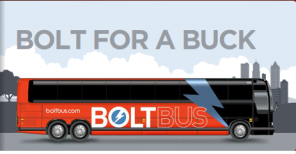 As Geekwire mentioned the other day, a new low-cost bus service is coming to town. As of May 17, 2012, BoltBus will offer 4-runs-per-day service between Seattle and Portland: 8:30 a.m., 12:30 p.m., 2 p.m., and 6 p.m., with the trip estimated to take three hours and 15 minutes.
As Geekwire mentioned the other day, a new low-cost bus service is coming to town. As of May 17, 2012, BoltBus will offer 4-runs-per-day service between Seattle and Portland: 8:30 a.m., 12:30 p.m., 2 p.m., and 6 p.m., with the trip estimated to take three hours and 15 minutes.
Prices will range depending upon demand (factors include day, time of day, advance purchase, number of tickets, trip sales volume): A promotional all-seats-$1 offer from May 17 through May 20 is selling out (though every regular trip sells one seat for $1, randomly), but after that your reserved seat (aisle or window?) will likely cost between $6 and $15 one-way. (You can purchase walk-up tickets, as well as online.) That is much less expensive than the Amtrak Cascades regular one-way fares of $32 to $45, and fifteen minutes faster (without adding in the risk of wintertime mudslides).
In Seattle, board your BoltBus at 5th Avenue South and King Street, next to the International District Station; it’ll drop you off at 647 SW Salmon Street in Portland, which is a bit more central than Amtrak’s Union Station. You can ease your transition at the Starbucks right there, if need be.
Because Portland is one of the most bike-friendly cities to visit you can imagine, my first question was whether I could bring a bike along. This led to a helpful tutorial on BoltBus baggage policy: “You are allowed one piece of baggage under the coach and two small bags to carry on (purse or backpack).” In theory, your bicycle is the under-the-coach item: “We do allow them and consider them to be oversize items as long as space is available in the baggage area.”
That “as long as space is available” seems to suggest that you should get there early with your bike. (BoltBus suggests checking in at least 15 minutes before departure anyway; at five minutes, reservations are released to stand-bys.) You are in charge of stuffing your bike into the compartment, by the way. Tag your luggage because: “If a bag is left mistakenly behind and is properly marked we will return it to you free of charge.” They don’t say if that applies to the “one infant under the age of two,” you’re allowed to bring on free as well. You can bring food and non-alcoholic drinks “for personal consumption,” and, happily, there’s a restroom.
First established in the northeastern U.S., BoltBus was a partnership between Greyhound and Peter Pan Bus Lines; way out west, it’s exclusively a Greyhound venture, employing yield management economics to offer low-cost fares. But Geekwire is more interested in the fact that BoltBus is that chimerical creature, a low-cost bus line with high-tech perks, emphasizing the “leather seats, free Wi-Fi, and electrical outlets so laptop hounds like us can geek out along the way.” There’s also extra legroom, and a buy-eight-trips-get-one-way-free offer for regular riders.
At the moment, the BoltBus site is distinctly no-frills. They promise mobile site “enhancements” are coming soon, and there’s a FAQ, but the main thing it does is sell you a ticket. Again, that’s in contrast to the Amtrak site, which boasts a scheduling widget that doesn’t understand “seattle, wa” as a departure. It’s “Seattle, WA (SEA),” thank you. Of course it is.
STP to Fill Saturday Morning Air with Roar of 20,000 Pedals
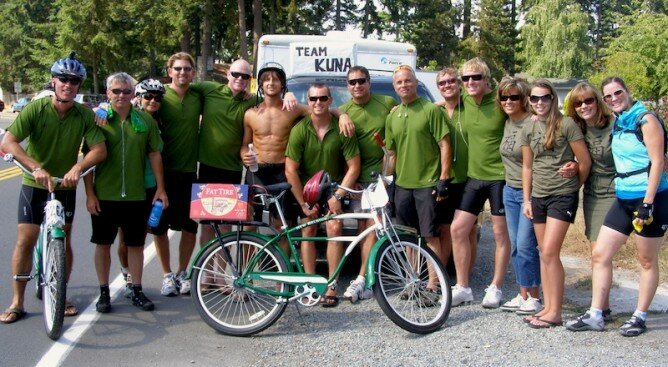
As Seattle Transit Blog reminds you, there’s a significant bicycle event happening this weekend, and if you’re not in it, you probably don’t want to stumble upon it on the way to pick up milk for your cereal:
Saturday is also the 32nd annual Seattle to Portland Bicycle Classic (STP). 10,000 cyclists (including yours truly) will make the 204-mile trek to Portland. For our mutual sanity and safety, you would do well early Saturday morning to avoid Montlake, the University Bridge, Lake Washington from Madrona to Renton, West Valley Highway, Puyallup, Pacific Avenue/SR7, and SR 507. [emphasis added]
The scene for the ride’s start is the University of Washington E-1 parking lot, on Montlake Blvd., just north of Husky Stadium. One-day riders depart from 4:45 a.m. to 5:15 a.m., and everyone else from 5:15 a.m. to 7:30 a.m., in 10-minute waves.
This is the sixth year for one of the more unlikely STP teams, the 25-member Cruiser Bike Team for Prader-Willi, sponsored by Snohomish’s meal assembly chain Dream Dinners.
The ride itself is sponsored by Group Health, so it’s not that unusual that the cyclists in Hawaiian shirts and flip-flops are raising funds for and awareness about Prader-Willi syndrome (it’s genetic, and kids who have it feel chronically hungry, along with suffering from learning issues).
It’s not a joke; they’re on 42-pound fat-tire cruisers for 204 miles and 22 hours, and team captain Mike Kuna says the experience is “like nothing else.” He did the first ride in 2006, with just one cyclist companion, and the team has been growing swiftly since–people who do it once, against all odds, come back the next year for more. Now they have cyclists from Washington, Oregon, California, Colorado, Ohio and Arizona.
Dream Dinners, besides supporting the team with bikes, logistics, and food, also runs Living the Dream Foundation, for online donations. Over the last six years, Dream Dinners and the cruisers have raised more than $50,000 for Prader-Willi research and treatment.
Seattle to Portland Bike Ride is Sold Out
 This July 9 and 10, some 10,000 bicyclists will ride the Group Health Seattle to Portland Bicycle Classic, a two-day, 204-mile trip that the more hardy will complete in one day. As of today, it’s sold out. Just to make it clear, today is March 21. The ride is in July.
This July 9 and 10, some 10,000 bicyclists will ride the Group Health Seattle to Portland Bicycle Classic, a two-day, 204-mile trip that the more hardy will complete in one day. As of today, it’s sold out. Just to make it clear, today is March 21. The ride is in July.
That’s right, spending the weekend doing 200 miles on a bike is something you can “sell out” over three months in advance, even with a $100 adult registration fee. 3,000 feet of elevation gain? Not a hindrance. Procrastinators, your only chance now is to see if the number of refunds demanded between now and the ride prompt the Cascade Bicycle Club to re-open registration. If that happens, registration will reopen no sooner than June 9.
The ride starts at the University of Washington E-1 parking lot on Montlake Boulevard, and finishes at Holladay Park in northeast Portland, near Lloyd Center, with a festival that includes showers and a massage tent.
Last year the oldest rider was 87, and participants from 43 states rode, in addition to cyclists from Australia, Canada (Alberta, B.C., and Ontario), the Dominican Republic, England, Germany, Japan, and Singapore. You may not know that Bicycling Magazine says it’s one of the top events in the nation (yes, yes).
Now, granted, this is one weekend in July, which is in theory the beginning of summer in the Northwest. But despite being a “weekend ride,” STP says something important about the utility of bicycles. First, you probably don’t want to ride more than 100 miles per day. But think of all the places you could get to that are under 100 miles away. Now think of all the places you get to that are under 10 miles away. What’s one mile away?
Secondly, about 20 percent of the STP riders have never done it before. It’s a pretty good bet that they wouldn’t just strike off on their own one weekend. What’s the difference? Everyone else is doing it. There’s safety–and guidance, comfort, support, repair, extra water bottles–in numbers. When “everyone” is doing something, barriers that were previously insurmountable tend to vanish.
These are important lessons, so let me restate them.
1) It’s not distance or speed, it’s mainly access that keeps bicycling from being a legitimate mode of transportation. If the average American drives 33 miles per day, it’s eye-opening to realize the average day could be biked. Yes, you’d be sweaty, and no, I’m not suggesting that as a goal. I’m just pointing out that distance isn’t the barrier it’s cracked up to be. People who don’t bike consistently underestimate what’s within the range of the average person on a bike (or, imagine that once you get on a bike, you can’t get back off it those days you might need a car).
2) Any individual cyclist can be ridden off the road (literally or metaphorically) by a motorist. There’s far more than safety in numbers, when it comes to cycling. There’s authorization. There’s “taking the road.” Do most commuter cyclists ride singly? I’d be curious what a Microsoft car bike pool program might accomplish. Bikes have an advantage over cars in this–riding in a group is fun. A group of cars is just traffic.
